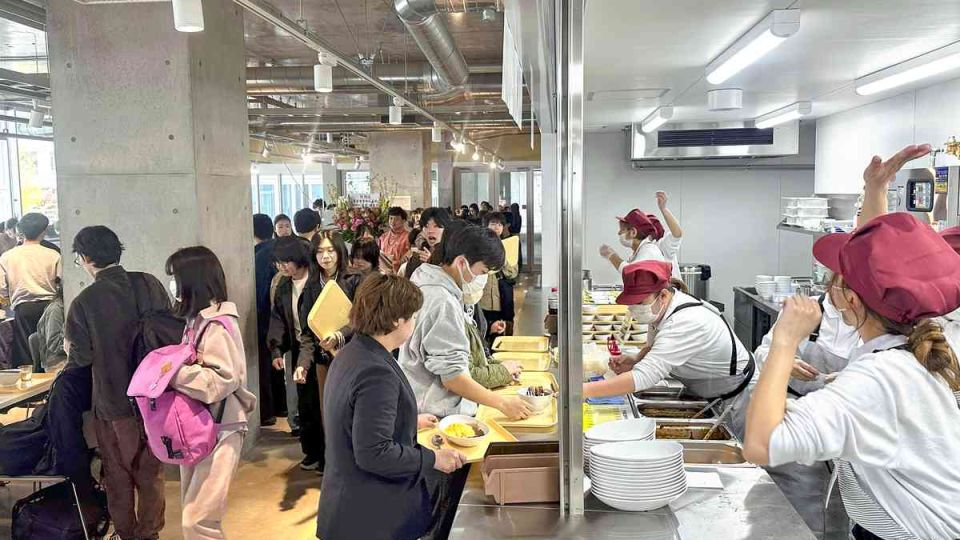June 9, 2025
KYOTO – Due to the sharp rise in food costs, university cafeterias, which support students’ diets, have been forced to increase prices. The impact is serious in Kyoto, where students make up 10% of the population. Although their operators, such as university co-ops, have strived to overcome the difficult situation, it is likely to continue for some time.
Water instead of tea
“We are doing our best … However, we have no choice but to increase prices again.”
In a written announcement, the Kyoto University CO-OP apologized in advance for increasing the prices for a second time of menu items that use rice at seven cafeterias in March, with increases between ¥13 and ¥100. The price rose by ¥55 for a midsize bowl of rice, ¥100 for an ultra-large bowl of rice and ¥90 for a large plate of curry and rice, among others.
In addition to the rising price of food costs, the co-op has been passing on higher labor, utility and distribution costs to the prices of menu items. The co-op has been further affected by the sharply rising price of rice since last year.
Rice is procured jointly by university co-ops nationwide. There may be another price increase in July or August.
According to a survey by the Kyoto University CO-OP, about 80% of the university’s students use cafeterias for lunch as a key part of their diet. Their average payment per meal, however, has remained at around ¥600, indicating that students are likely dealing with the price increases by excluding a small side dish and miso soup from their meals.
“The image of university cafeterias serving affordable meals has completely changed,” said Takahiro Fujii, 21, a fourth-year law student from Kudamatsu, Yamaguchi Prefecture. “There is also no sign of a price reduction.”
The Kyoto University CO-OP continues to operate on a tightrope, with a deficit of ¥106.6 million in fiscal 2024 and an accumulated deficit of ¥238 million.
To deal with this situation, the co-op in March stopped offering free tea at three cafeterias, even though the service had been popular, and installed water dispensers instead.
The co-op expects this to reduce expenses by more than ¥10 million annually. However, Taichi Abe, who is in charge of the cafeteria division, said with concern, “The price of rice is rising rapidly, and we cannot foresee what the situation will be like.”
¥500 meals impossible

A meal combination including rice in a midsize bowl, soup, a main dish and a small side dish costs ¥605 at a Kyoto University CO-OP cafeteria in Sakyo Ward, Kyoto. PHOTO: THE YOMIURI SHIMBUN
On April 10, Kyoto City University of Arts in Shimogyo Ward opened its long-awaited cafeteria just in time for the start of the new academic year. However, the rising cost of food casts a shadow here, too.
When the university relocated to its current location in October 2023, it was unable to have a cafeteria because the limited budget did not allow for constructing a kitchen and related facilities. A year and a half later, the cafeteria was finally opened with the university and the Kyoto city government equally sharing the cost of about ¥120 million.
The cafeteria has been well-received by the students, who often used to get their lunches from convenience stores.
“I hope there will be more menu items,” said Nodoka Yamaguchi, 20, a second-year student in the Faculty of Fine Arts.
The cafeteria is operated by Fujiya Shoji Co. in Nishikyo Ward, which runs cafeterias at about 100 schools, mainly in the Kinki region.
As the university has only about 1,000 students, the company only opens the cafeteria for lunch on weekdays, from 11:30 a.m. to 2:15 p.m., and allows the public to use it as well, in an effort to ensure its profitability.
The set menu items are priced between ¥550 and ¥650.
In initial discussions with the university, the company had planned to offer “one-coin set meals” priced at ¥500. But it had to abandon the plan due to rising food costs.
Hirohisa Yamamoto, an area manager of the company’s sales department, expressed concern, saying: “We don’t want to disappoint students, but if food and labor costs continue to rise, it will be tough.”
¥100 breakfast

A cafeteria at Ritsumeikan University that offers a ¥100 breakfast is seen in Kita Ward, Kyoto. PHOTO: THE YOMIURI SHIMBUN
Despite higher costs, cafeterias at Ritsumeikan University continue to serve a ¥100 breakfast, which has become more popular recently. This spring, the breakfast was served to more people than in spring 2024.
The cafeteria serving the ¥100 breakfast in the Zonshinkan Hall at the university’s Kinugasa Campus in Kita Ward is already crowded before the first class of the day. The ¥100 breakfast consisting of rice in a small bowl, miso soup and two small dishes would usually cost about ¥400.
The very affordable breakfast has been offered since 2013, thanks to supplementary funding from the university’s Parents Association of Student Education Assistance.
“As prices are rising for everything, it’s not easy to cook for myself,” said Tomoaki Hirabayashi, 20, a third-year law student from Nagano Prefecture. “I’m grateful that the price is kept at ¥100.”
According to the Ritsumeikan Consumers Cooperative, the breakfast was served on all campuses to a daily average of 1,309 people in the first half of April, up about 17% from 1,120 served in April last year.
The increased cost of food has been offset by reforming various operations such as saving water.
Hiromi Matozaki, a general manager of the cafeteria department, said: “Outside the university, it’s no longer possible to buy an onigiri rice ball or bread for ¥100. We want students to eat well in the cafeterias.”

